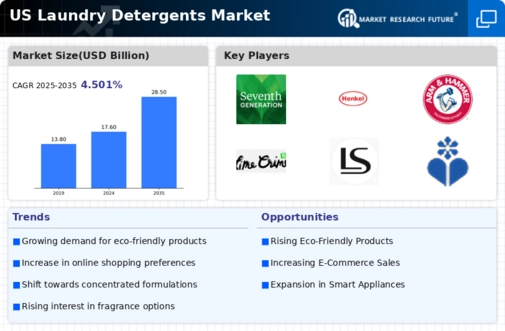Rising Consumer Awareness
The laundry detergents market is experiencing a significant change as consumers become increasingly aware of the ingredients in their cleaning products. This heightened awareness is driving demand for transparency in product labeling and formulation. As a result, brands that prioritize clear communication about their ingredients are likely to gain a competitive edge. According to recent data, approximately 70% of consumers in the US express a preference for products that are free from harmful chemicals. This trend suggests that manufacturers in the laundry detergents market must adapt their offerings to meet these evolving consumer expectations, potentially leading to a rise in sales of eco-friendly and non-toxic products.
Convenience-Oriented Packaging
The demand for convenience in everyday tasks is influencing the packaging strategies within the laundry detergents market. Single-use pods and concentrated formulas are gaining traction as they offer ease of use and precise dosing. This shift towards convenience is particularly appealing to busy households, where time-saving solutions are prioritized. Recent surveys indicate that nearly 60% of consumers prefer packaging that simplifies the laundry process. Consequently, manufacturers are likely to invest in innovative packaging solutions that cater to this demand, potentially reshaping the competitive landscape of the laundry detergents market.
Growth of Online Retail Channels
The expansion of online retail channels is reshaping the shopping experience for consumers in the laundry detergents market. E-commerce platforms are providing greater accessibility to a diverse range of products, allowing consumers to compare options and read reviews before making purchases. Recent statistics indicate that online sales of laundry detergents have increased by 25% over the past year, reflecting a shift in consumer purchasing behavior. This trend suggests that traditional retail strategies may need to adapt to the growing importance of online presence, as brands seek to capture the attention of digitally-savvy consumers.
Sustainability Initiatives by Brands
Sustainability is becoming a core focus for many brands within the laundry detergents market. Companies are increasingly adopting eco-friendly practices, such as reducing plastic waste through refillable packaging and promoting biodegradable ingredients. This shift is not only a response to consumer demand but also aligns with broader environmental goals. Data suggests that brands emphasizing sustainability can expect to see a 10% increase in customer loyalty. As consumers gravitate towards brands that demonstrate a commitment to environmental stewardship, the laundry detergents market is likely to witness a transformation in brand loyalty dynamics.
Technological Advancements in Formulation
Innovations in chemical engineering are significantly impacting the laundry detergents market. The development of advanced formulations that enhance cleaning efficiency while reducing environmental impact is becoming increasingly prevalent. For instance, the introduction of enzymes and biodegradable surfactants has improved stain removal capabilities, appealing to consumers seeking effective yet sustainable solutions. Market data indicates that products featuring these advanced formulations are projected to capture a larger share of the market, with an expected growth rate of 5% annually. This trend highlights the importance of research and development in maintaining competitiveness within the laundry detergents market.























Leave a Comment